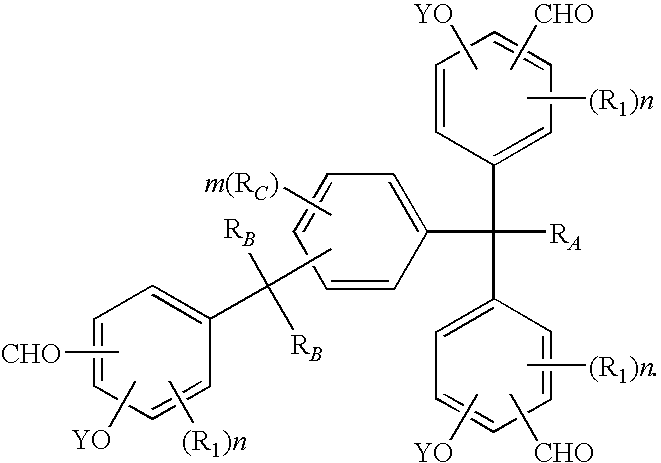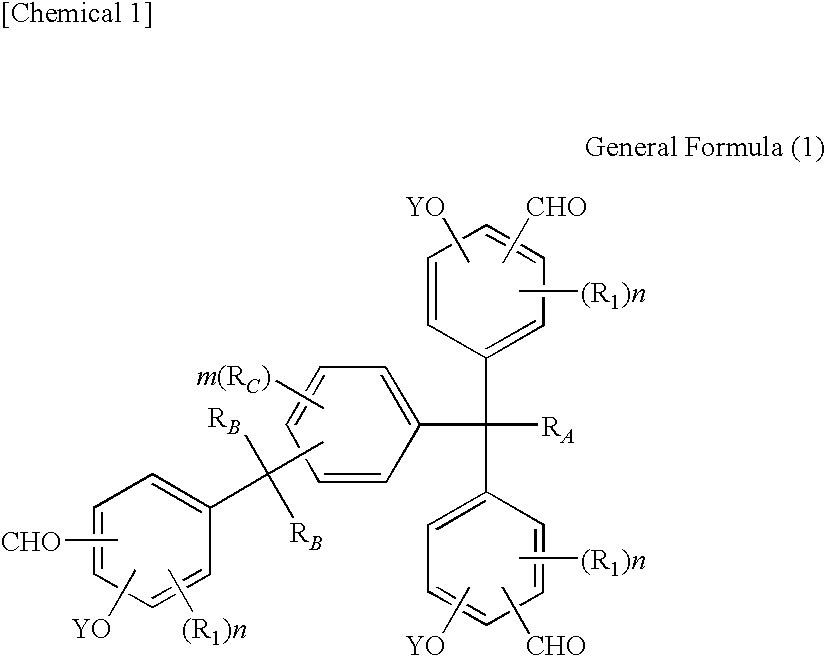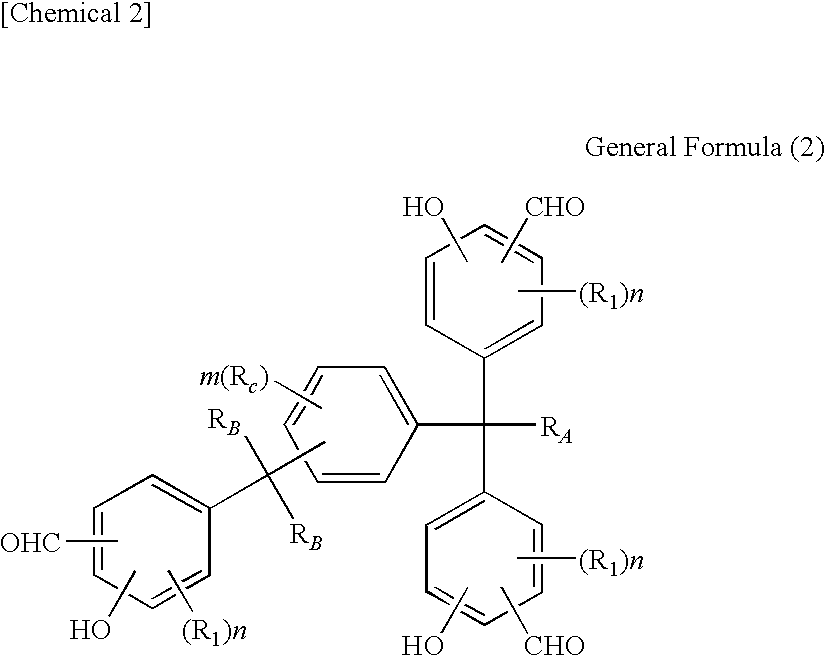Tris(formylphenyl) and novel polynuclear phenol derived therefrom
a technology of trisformylphenyl and polynuclear phenol, which is applied in the field of new tris (formylphenyl) and novel polynuclear phenol derived therefrom, can solve the problems of asymmetric structure of trisformylphenyl compounds, unknown aromatic rings, and lack of unsaturated bonds, and achieve excellent heat resistance and reactivity, excellent reactivity, excellent reactivity
- Summary
- Abstract
- Description
- Claims
- Application Information
AI Technical Summary
Benefits of technology
Problems solved by technology
Method used
Image
Examples
example 1
Synthesis of 1-[α-methyl-α-(3-formyl-5-methyl-4-hydroxyphenyl)ethyl]-4-[α,α-bis(3-formyl-5-methyl-4-hydroxyphenyl)ethyl]benzene
[0291]410.4 g (3.6 mols) of trifluoroacetic acid was put in a four-way flask with a capacity of 1 liter and the reaction container was replaced by nitrogen, after which 92.4 g (0.66 mol) of hexamethylenetetramine was added at a temperature of approx. 30° C. and then 111.4 g (0.2 mol; purity 92.4% based on high-speed liquid chromatography) of 1-[α-methyl-α-(3-hydroxymethyl-5-methyl-4-hydroxyphenyl)ethyl]-4-[α,α-bis(3-hydroxymethyl-5-methyl-4-hydroxyphenyl)ethyl]benzene was added under agitation at a temperature of 60° C. over 2 hours to achieve reaction. After the entire quantity had been added, the mixture was agitated further for 5 hours at 85° C. to achieve reaction.
[0292]After the reaction, 240 g of water was added to the obtained liquid, which was then hydrolyzed for 1 hour at a temperature of 60° C. Viscous solids precipitated during this reaction. Afte...
example 2
Synthesis of 1-[α-methyl-α-(3-bis(2,5-dimethyl-4-hydroxyphenyl)methyl-5-methyl-4-hydroxyphenyl)ethyl]-4-[α,α-bis(3-bis(2,5-dimethyl-4-hydroxyphenyl)methyl-5-methyl-4-hydroxyphenyl)ethyl]benzene
[0297]44.0 g (0.36 mol) of 2,5-xylenol and 44 g of methanol were put in a four-way flask with a capacity of 1 liter and 35.2 g of hydrochloric acid gas was blown into the flask at a temperature of 30° C., after which a solution produced by dissolving 87.8 g (0.72 mol) of 2,5-xylenol in 175.6 g of methanol was drip-fed, and then 82.6 g (0.15 mol) of 1-[α-methyl-α-(3-formyl-5-methyl-4-hydroxyphenyl)ethyl]-4-[α,α-bis(3-formyl-5-methyl-4-hydroxyphenyl)ethyl]benzene obtained by Example 1 was added at a temperature of 30° C. over 1 hour 30 minutes to achieve reaction. After the reaction, the mixture was agitated further for 4 hours at a temperature of 40° C. to achieve reaction.
[0298]After the reaction, 241.2 g of 16% aqueous sodium hydroxide solution was added to neutralize the obtained reaction li...
example 3
Synthesis of 1-[α-methyl-α-(3-formyl-4-methoxycarbonylmethoxy-5-methylphenyl)ethyl]-4-[α,α-bis(3-formyl-4-methoxycarbonylmethoxy-5-methylphenyl)ethyl]benzene
[0305]27.5 g (0.05 mol) of 1-[α-methyl-α-(3-formyl-5-methyl-4-hydroxyphenyl)ethyl]-4-[α,α-bis(3-formyl-5-methyl-4-hydroxyphenyl)ethyl]benzene obtained by Example 1 was put in a four-way flask with a capacity of 500 ml and the reaction container was replaced by nitrogen, after which 68.8 g of N-methylpyrrolidone was added to dissolve the material. Next, the solution was heated to 50° C., and then 2.75 g (0.017 mol) of iodinated potassium and 24.2 g (0.175 mol) of potassium carbonate were added and the mixture was agitated at the same temperature for 1 hour.
[0306]Next, the mixture was heated to 70° C., and 32.6 g (0.3 mol) of methyl acetate chloride was drip-fed over 1 hour. After the entire quantity had been added, the mixture was agitated further for 6 hours at 75° C. to achieve reaction.
[0307]After the reaction, 100 g of water ...
PUM
| Property | Measurement | Unit |
|---|---|---|
| glass transition temperatures | aaaaa | aaaaa |
| temperature | aaaaa | aaaaa |
| temperature | aaaaa | aaaaa |
Abstract
Description
Claims
Application Information
 Login to View More
Login to View More - R&D
- Intellectual Property
- Life Sciences
- Materials
- Tech Scout
- Unparalleled Data Quality
- Higher Quality Content
- 60% Fewer Hallucinations
Browse by: Latest US Patents, China's latest patents, Technical Efficacy Thesaurus, Application Domain, Technology Topic, Popular Technical Reports.
© 2025 PatSnap. All rights reserved.Legal|Privacy policy|Modern Slavery Act Transparency Statement|Sitemap|About US| Contact US: help@patsnap.com



